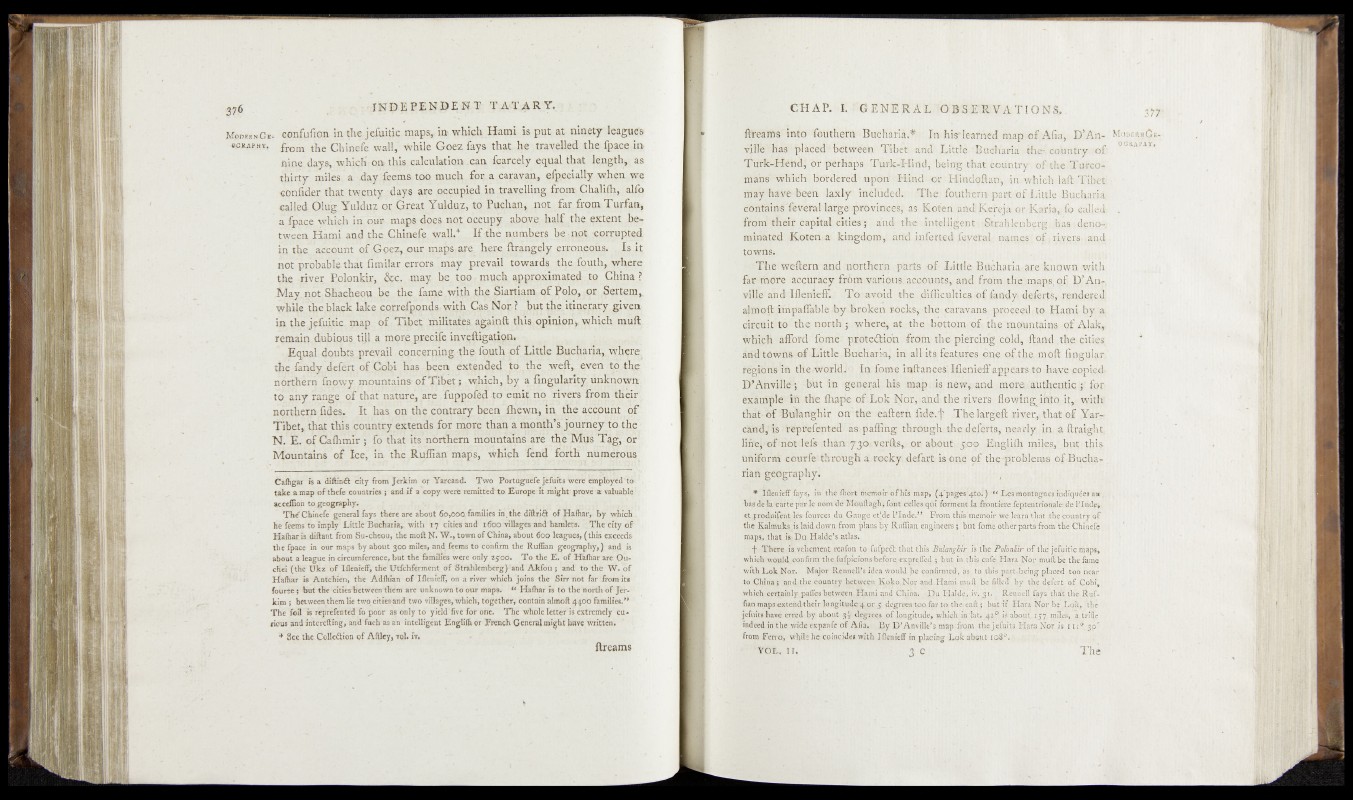
37$
M odern ©GRAP;
-jN D -E P E N D E 'W TA-TARY.
G*i eenfufrön m ffieyefuitic maps, in? which, Hami is put at ninety league
Wte' irom the Chinefe wall,' tfrhile Goez fays that he travelled the fpac-e in
w h iç h ' Q a t h i s r(3 aicu ltó in n . c a n J fia rc e ly ç<pial t h a t - k $ g |h g as
thirty miles a .day Teems too much for a caravap, efpecially when we
■cnnkHfr that twenty :days are in alfq
effie4 £3ug,¥uldu£ or. Great TnWh?»
a fpace whieh m a p â n^^PMPy hf^,.thÇv|^«p.i^!
tween. ïîàffli and thé Chinefe waft.* If the auorf).ere
i n t h e J n ^ Q u n t Ô f î0 P § ? ^ jP n r ï j ^ f i j i j a t e .here ftrangely
notprobable.that fimBrir errors 'may prevail towards the.^hnth» where
the river Polonhir, Sec., may be/too- much approximated:.,^ China?
.May.npt Shaçhepu be., the facqye wi.th the Siartiam qf ^©Jo, or Sçftem^
while the black lake «)^îîî ill®' S*yeti
in thejefuitic map of Tibet militates agaioft thisopinifiwiy which muft
remain dribigus. ti)l a more precife inveftigatian.
- Equal dQubts prevail çqnçerpingçffif- fouth of, fettle Ê^cbpiaj.lW&fre;
t|t£ Tandy defeit of Cobi has been extended to , the weft, oven IjO.the
northern ïhowy mountfi™ ° f Tibet ; wffich, by a fingukrity, unknown
to any. range of that nature, are ‘fuppofêa id em i| no fivers from their'
northern fides. It has on the contrary been ffiewnyiiy the accOunt .of
Tibet, that this country extends for more than a month’aj^rhey-to the;
N. E. of Calhmir ; fo that its'northern mountains are of1
Mountains of Ice, in the Ruffian maps, which lénij'.form' numerous'
Cafhgar Is a diftinft city from Jerkim of Yarcand. Two Pörtügnéfe jèfuits were employed‘ïó'-1,
take a map of tbefe countries ; and if a'copy werfc remitted to Eifrope It might' prose -« valuable
acceffion to geography.
The'Chinefe' general fays there are about do,OOQ, families in.the diftrift of Hafhar, by which
he feems to imply L-ittlèBucharia, with 1.7 cities-and 1600 'villagesandhamlets. . The city of'
Hafhar is diftant from Su-cheou, the moll N. W-, town of China, about 600 leagues, (this exceeds
the fpace in our maps by about 300 miles, and feems to confirm the Ruffian geography, ) and is
about a league in circumference, but the families were only 2-Joo. To the E. of Hafhar are Qu-
chei (the Ukz o f Ulenieff, the'Uffchférment, of 'Strahlémberg) and Akfou ; and to the W. of
Hafhar is Antchien, the Adfhian of- Ulenieff, on a river which joins the Sirr not far '.from its
fourje ; but the cities between them are unknown to our maps. “ Hafhar is to the north of Jerkim
; between them lie two cities and two villages,which, together, contain almoft 4400 families.”
The foil is réprefented fo poor as only to yield'five for one. The whole letter is extremely curious
andinterefting, and fuch as an intelligent Eiigliffi or French General might have written.
'* See the Colledtion of AlUey, vol. iv.
ftreams
c h a p. i. G e n e r a l o b s e r ' v a t io n s . .
ftreams into fouthem BuchariaA . In hisTearned map of Afia, D’An- M'
vlITilb^bas‘'’placedybe{Weeu ' Tibetf^rfd’. Little-"BuCharia1 &e- country of °
Turk-Henck or perhaps;-Turk-Hind, being that country of-tiie-Turcomans
which bordfcrecl upon Iliad ;cif HindWftaff, in Which laft Tibet
may have been laxly included. The - foutliarn:- part of Little -Bucharia,
containsTeveral large provinces,'as Koteri and! Kerfej|||r Karia^ if© cailed .
from their capital cities; and ©®^^^l|ig&m&&ti'ahilcnbcS|has deno-v
minated Koteri: a kingdom, arid inferted. feyetaj^ <rW®§sI o£} fiy^rs-.^ud-.
town«!
The weftern and northern parts of Little Bflpbar#%llfJe JknOWjri);’jvjth
famfripre accuracy from ■-various,'aeqoi|$$Sy and from-^e^map^, ofiM-Am-,
ville and Ulenieff. To. avoid the djfficuftieWof (anolyyjtrig-^,.
alrAoft^ifripaflWblh(hy-bHpken>,tocks,‘'ffieicW:av^^s,:'prbee5jjW^Sfe31vvbyf3t
clt-CtiitvW)'the northy -where, at^u~k.©t^c^/o^thejma^ptaiu^sf;Alak,
which -afford ftuftte-T pirdtecSnon frciriv thei pier <3^ngW<|<$ld& git-ies;
arid townS-.Q-f-Little ButeHam,’ albit«| features one q£,the
regions in the »world. In fome inftanc.es’ Iflenieffiagpifars to
D?Ari43lte'-; hht in general bis map. is alw^and
example i’ri the ftytpe of'jhrik'^or^ajxd- the triver^ £owteg-Ii^qcit,- with'
that' of 'Btflarfghif on'the 'eaftesrn fide.'jf Thrid'Wrg'sft ^<i#r.yhat'@|' ,Y*arr'
cand, is reprefen ted as paffing through the deferts, nearly in ra ftfaight;
lirie|>°f not lefs .-than 730. verfts, or about ,500 Kiiglifla miles, but this
uniform courle’ through a rocky, defart is one of the-problemfi of'Bucher
rian geography. f
*, Iflenfeff fays, in the fhort memoir oFlifs map, (4'pagcs;4t6.;)‘.tff AeJnSbtflhgnesjSidiqtfeea a«1. ,
bis de-la Carte phr le iMm'de Mo’uftaghf font1 celles qui forment lafixmtiere fep ten trio n ale c] e l’lndc, ■
et prodpifentids'fo.urces da Gauge et'de l’Inde.” From thi's'membir wc learn that the «untry of
the Kalmuks is laid dciwn from plans py Ruffian engineers; but fomeipther.parts from1 tliejChinefc t
maps, that is;Du Halde’s atlas.
.- f There, is yeljenient reafon to fyfee^t that this BuTangbir is the Wo&W'fiV of the jefuitic maps,
which'w6pl!L<5yBfeitt'tbe5fi}&ici6ins;brfore, exprefTe4; but in t h i s .
with Lok Nor. Major ‘RenneE’s idea Would be confirmes)!; ps to this part Aei-ng placed. too near -
to China.; spid;the country t^etween' Rc(^o..H^ir apdrHamiinufl^be-fijleff byXtM 'dVkrt of Colt, ■
which certainly palfes'between Hami an.1! China. Du Hal^y, it. 31. Ren 11 etffjys that the Ruf- ;
fian mapsiextcjid.'their longitude 4 or, ^ (jcgi'^stpafaf to. the,eafl,j but if HaraNppTe Lolc, the
jefuitshave erred by about 3-^ degrees of.l^ngitude, .\vliichj'n'lat. ;42° miles,, a trific
indeed in ifee ^ide expanfe o f Afia. > B y D’Anville’s map -from -tljejjjfujt? Hara Nor. is. it 1^30'
from Ferro, gltii'e he coincides, with Iflenieff in- pKci-ng 'Lo& abOnt |p,8;? JM |
yV o a . 11. ?- 3 e| The